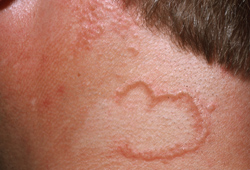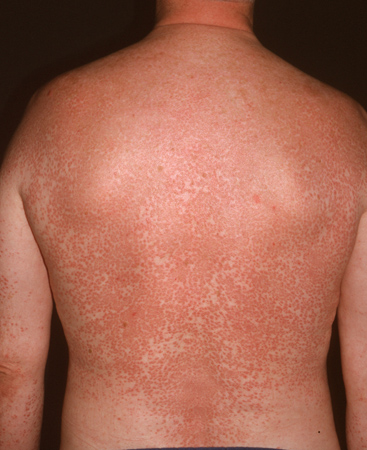Approach
The clinical presentation of this disease is a spectrum; it may arise as a solitary lesion or a generalised eruption. There are no specific guidelines for the investigation of this disease, and management is usually physician-dependent. Diagnosis is typically clinical.[32]
History and examination
Patients are usually asymptomatic and systemically well.
Localised[Figure caption and citation for the preceding image starts]: Classic localised granuloma annulareFrom the collection of Susmita Mukherjee, BSc, MBBS, MRCP; used with permission [Citation ends].
Children and young adults commonly present with a non-itchy rash on the dorsum of their hands, feet, or extensor aspects of arms.
Consists of papules often arranged as annular plaques.
Plaques are typically flesh-coloured or with a pink/purple hue.
Generalised[Figure caption and citation for the preceding image starts]: Generalised granuloma annulareFrom the collection of Susmita Mukherjee, BSc, MBBS, MRCP; used with permission [Citation ends]. [Figure caption and citation for the preceding image starts]: Generalised granuloma annulareFrom the collection of Susmita Mukherjee, BSc, MBBS, MRCP; used with permission [Citation ends].
[Figure caption and citation for the preceding image starts]: Generalised granuloma annulareFrom the collection of Susmita Mukherjee, BSc, MBBS, MRCP; used with permission [Citation ends].
Papules are pale and distributed across the body in a symmetrical fashion, particularly over the torso.
Subcutaneous
May present with a painless solitary soft-tissue nodule, which can occur in many sites from the palms, feet, and buttocks to the scalp or eyelids.
It is most common in children <5 years of age but can be seen in adults.
Perforating
Crusting or ulceration can often be seen.
May be evidence of hypopigmentation in scars at the site of previous lesions.
Can also affect the whole body, but most commonly affects the upper limbs.
Patch
Rare variant.
More commonly seen in intertriginous areas.
Lesions are slightly infiltrated erythematous plaques with a palpable border, on which scattered papules may arise.
In rare cases, GA can develop as a paraneoplastic granulomatous reaction to internal malignancy; however, these cases normally have different clinical features than standard GA. There are usually clues in the history and examination, such as sudden weight loss, unexplained anaemia, palpable organomegaly, or lymphadenopathy. If patients have atypical variants of GA (palmar plaques, erythroderma), or GA occurs in patients aged over 65 years, consider age appropriate cancer screening; with atypical variants or systemic symptoms, consider evaluation for underlying malignancy, particularly haematological disease.[6][8][15][16] Finally, medications may rarely trigger GA, and a thorough review of potential inciting medications is warranted.[17] Cases of GA developing after bacilli Calmette-Guerin (BCG) vaccination have also been reported.[30][31]
Investigations
Diagnosis is typically clinical; tissue biopsy is rarely needed.[32] Indications to consider a biopsy would be a subcutaneous lump that was rapidly growing in size or causing pain (raising suspicion of a malignant process such as lymphoma or soft-tissue sarcoma), or when diagnosis is uncertain and another condition such as sarcoidosis is suspected. Histopathologically, an infiltrate of histiocytes and a sparse perivascular infiltrate of lymphocytes can be seen. An increased level of mucin is the hallmark of GA, and this can be shown with either alcian blue or colloidal iron.
If diabetes is suspected by a strong family history or symptoms, the patient presents with generalised GA, or the patient is 40 years or older, a fasting blood sugar test is recommended. A weak association has been described.[11] Thyroid abnormalities may be seen in patients with GA, and work-up should be considered if symptoms dictate.[12][13] Hyperlipidaemia may also be more common in patients with GA, and consideration should be given for checking fasting lipid profiles.[14] GA has been reported among people with HIV, including atypical presentations of GA, and a thorough history should be performed; if indicated, additional laboratory work-up may be considered in the appropriate clinical setting.[27]
Use of this content is subject to our disclaimer